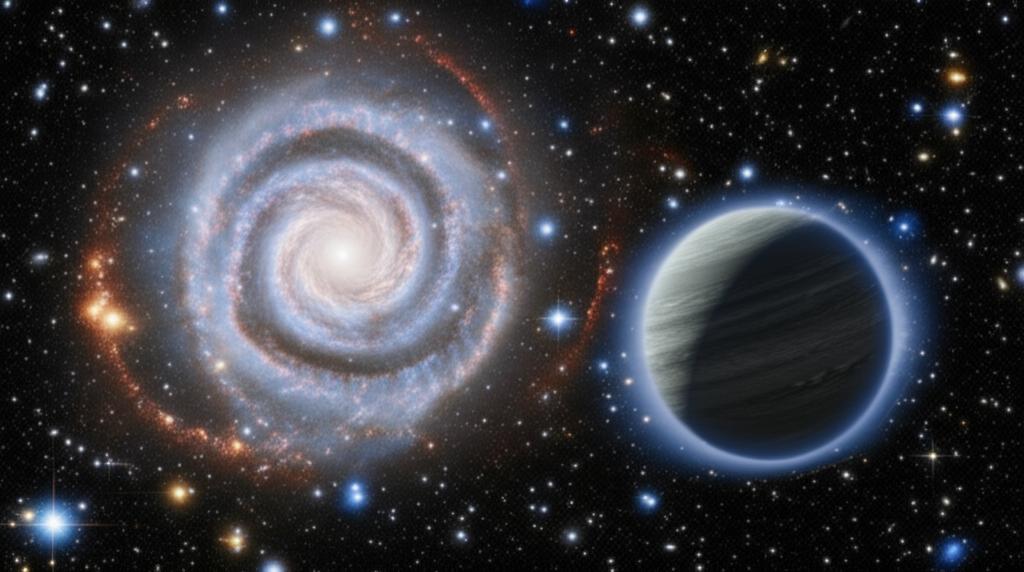Imagine a cosmic ballet on the grandest of scales, where galaxies pirouette and supermassive black holes at their hearts flare up as brilliant quasars. These aren't just any light shows; they are powerful engines that can reshape their entire galactic neighborhoods. This is the essence of "The Quasar-Powered Galactic Joust," a field of astronomy buzzing with new discoveries that unveil the intricate dance of cosmic feedback.
At the center of this spectacle are quasars, intensely luminous beacons powered by gas spiraling into supermassive black holes. When galaxies collide and merge – a common occurrence in the universe's history – these central black holes can roar to life, unleashing torrents of energy and matter. This "feedback" is a crucial mechanism in how galaxies evolve, influencing everything from star formation to the galaxy's ultimate fate.
New Revelations in Galactic RestructuringRecent groundbreaking research published in Nature provides a direct look at this interplay. Astronomers observed two massive galaxies in the throes of a merger, an event that ignited a quasar. What they found was fascinating: the quasar's intense radiation was profoundly altering the molecular gas in its companion galaxy. This gas, the fuel for new stars, was being compressed into extraordinarily compact and dense cloudlets, far smaller than typically seen. This "molecular metamorphosis" appears to be a form of negative feedback, where the quasar doesn't just blow gas out of the galaxy, but changes its internal structure, making it harder for new stars to be born. This highlights that quasar feedback can operate on surprisingly small, cloud-level scales, not just on a grand galactic one.
Outflows: The Galaxy ShapersFor a long time, scientists have theorized that powerful outflows of molecular gas, driven by quasars, play a vital role in shaping galaxies. Recent observations using the Atacama Large Millimeter/submillimeter Array (ALMA) have provided strong evidence of these outflows even in the early universe, when it was less than a billion years old. By ejecting vast amounts of molecular gas – the very stuff stars are made of – into intergalactic space, quasars can effectively hit the brakes on star formation within their host galaxies. These findings confirm that quasars are capable of suppressing star formation by getting rid of the fuel needed.
A Complicated Relationship: Suppression and TriggeringHowever, the story isn't always one of simple suppression. Some studies suggest a "double role" for these galactic outflows. Observations of quasars at a cosmic redshift of z ~ 2.4 (meaning we're seeing them as they were when the universe was much younger) show that while fast outflows can indeed suppress star formation in the regions they directly impact, star formation can still occur in other parts of the galaxy. In some cases, the edges of these outflow cones even show signs of triggered star formation, a phenomenon known as positive feedback. This implies that the impact of quasar feedback might be more localized, or that multiple episodes of feedback are needed to completely halt star formation across an entire galaxy.
The Surprise of Spiral QuasarsAdding another layer to this cosmic joust is the recent, surprising discovery of quasar jets in spiral galaxies. Traditionally, these powerful jets, which are streams of superheated plasma ejected from near the black hole, were thought to primarily occur in massive elliptical galaxies. Elliptical galaxies are often the product of major galaxy mergers, which were believed to be necessary to funnel enough material towards the black hole to launch these jets.
However, NASA's Hubble Space Telescope recently revealed a quasar named J0742+2704 residing in a galaxy with distinct spiral arms. This finding challenges the long-held belief that major mergers are the sole trigger for quasar jets. While the spiral structure appears largely intact, Hubble did capture intriguing hints of interaction with other galaxies, such as a distorted tidal tail of gas. This suggests that perhaps less dramatic interactions, or other internal galactic processes, might also be capable of igniting these powerful jets. This discovery has opened up new questions about the diverse pathways for jet formation and how quasars in different types of galaxies influence their surroundings.
Unveiling the Early UniverseQuasars, due to their immense brightness, offer a peek into the conditions of the early universe. Discoveries of quasars existing when the cosmos was less than a billion years old help astronomers study a period known as "cosmic reionization," when the first stars and galaxies lit up the universe. Recent observations with the JWST have even found a quasar at a redshift of z = 7.642, the most distant yet known, hosted by an intensely star-forming galaxy. Studying such ancient quasars and their feedback mechanisms is crucial for understanding how the first supermassive black holes grew and how they co-evolved with their host galaxies in the dawn of cosmic time.
The ongoing exploration of quasar-powered galactic jousts continues to paint a dynamic and complex picture of galaxy evolution. From rearranging molecular gas clouds to launching colossal outflows and even appearing in unexpected galactic homes, quasars are far more than just distant, bright objects. They are active participants, powerful sculptors shaping the cosmos we see today. Each new observation brings us closer to understanding the full impact of these cosmic powerhouses.

